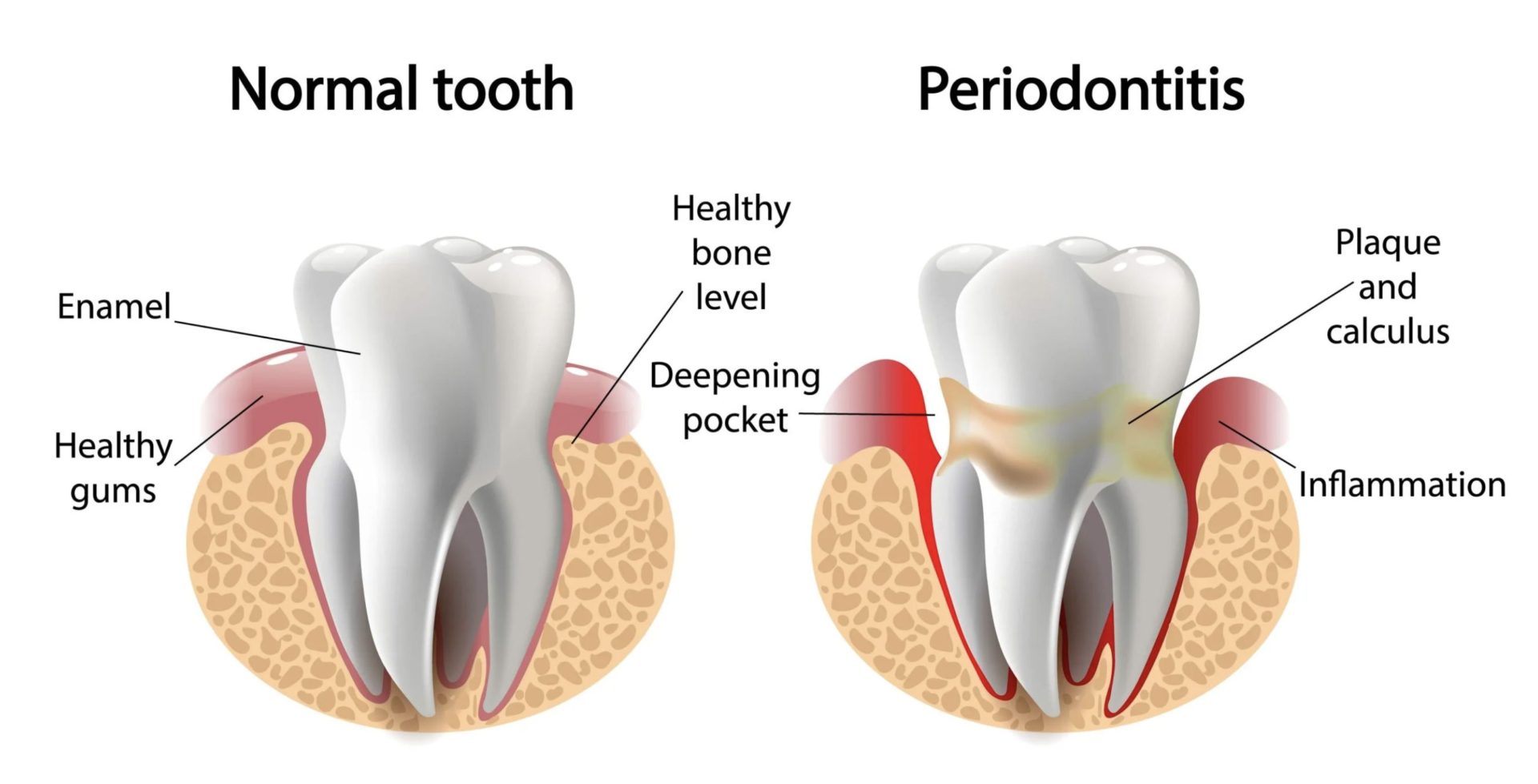Table of Contents
What is periodontitis
Periodontal disease, sometimes called gum disease, is a collection of inflammatory disorders that affect the tissues that surround the teeth. Periodontitis, or gum disease, is a serious infection of the gums. It’s brought on by germs that have accumulated on your teeth and gums. As periodontitis progresses, your bones and teeth may be affected.
periodontitis Causes
Poor dental hygiene is the most common cause of periodontitis. When you don’t brush your teeth or clean in hard-to-reach areas of your mouth, you’re inviting bacteria into your mouth.
Causes for periodontitis are :
Gingivitis is caused by inadequate or insufficient oral hygiene, which leads to the deposition of dental plaque, a mycotic and bacterial matrix near the gum line.
Poor diet and underlying medical concerns such as diabetes are other factors.
Smoking is another factor influencing the incidence of periodontitis, either directly or indirectly, and complicates or prevents therapy.
Periodontitis has been linked to a greater level of stress.
Periodontitis risk appears to be determined in part by genetics.
If you don’t brush away the plaque, the bacteria will begin to gather minerals.This mineral buildup is known as tartar, and it encourages bacterial development toward the tooth’s root.
Dangerous anaerobic bacteria proliferate and thrive in the pocket, generating toxins that harm the gums, teeth, and supporting bone structures.
Symptoms of periodontitis
Periodontitis symptoms include:
Gums which :
Bleeding gums .
Grows reddish-purple, bloated, and painful.
Accept (tissue pulls back, so more of your teeth show).
Teeth with:
Allow yourself to loosen up.
Feel empathetic.
Become engulfed with pus.
They appear to be longer (from receding gums).
Other signs and symptoms include:
Bad breath is a problem.
Your bite will change (way your lower and upper teeth come together).
Chewing is excruciating.
Types of periodontitis
Gum disease comes in a variety of forms, but all of them require rapid treatment by a dentist to stop the illness from progressing and save the gum tissue and bone.
Gingivitis
Gingivitis is the mildest and most prevalent form of periodontitis. Toxins in plaque induce this illness, which can progress to more severe types of periodontal disease. The following people are at a higher risk of getting gingivitis:
- Women who are expecting a child,
- Diabetic patients who are unable to regulate their condition
- Those that use birth control tablets,
- Users of anabolic steroids,
- People who use medicine to regulate their seizures and blood pressure.
Aggressive Periodontitis
A kind of periodontitis that affects persons who are otherwise healthy clinically. Symptoms include rapid attachment loss, bone degradation, and family aggregation.
Chronic Periodontitis
This type of periodontal disease causes inflammation in the teeth’s supporting tissues, as well as increasing attachment and bone loss, as well as pocket development and/or gingiva recession. It is the most common type of periodontitis and affects people of all ages. It is more common in adults, although it can affect anyone at any age. Attachment loss usually happens gradually, but it might speed up at times.
Periodontitis as a Symptom of Systemic Illness
Periodontitis is a chronic gum disease that often develops in infancy and has been related to a number of systemic diseases, including diabetes.
Stages of periodontitis
Periodontitis can be classified into four stages:
Stage 1: Initial Periodontitis
If gingivitis is not treated, it can swiftly progress to stage one periodontitis, which is quite damaging. Gum inflammation is caused by bacteria and plaque buildup both above and below the gum line. The first stage of periodontitis is treated with a deep cleaning procedure known as debridement. Gingivitis is reversible, while periodontitis stage 1 is not.
Stage 2: Moderate Periodontitis
The damage between the ligaments of the tooth’s root and its socket is the fundamental distinction between beginning periodontitis and moderate periodontitis. In the early stages of periodontitis, the damage is minimal and may even be unnoticeable. Moderate periodontitis, on the other hand, causes more visible and, sadly, irreversible damage.
Stage 3: Severe Periodontitis with the possibility of tooth loss
Because of extensive gum recession, your teeth may seem longer when you reach stage 3. Additionally, because the gums are not keeping your teeth firmly in place, you may notice that they are getting looser or shifting. Periodontal surgery may be the only therapy option at this stage. Your teeth may not be able to be preserved with a dental implant if they have deteriorated that much. Unfortunately, tooth extraction may be necessary as a final option.
Stage 4: Severe, with the possibility of tooth loss
A patient has already lost many teeth due to periodontal disease and may need to lose more teeth at this point. Patients with periodontitis stage 4 have few alternatives and may be sent to a periodontist who specialises in such conditions.
Treatment for periodontitis
The primary goal of therapy is to remove germs from the pockets surrounding the teeth and prevent additional bone and tissue deterioration.
Nonsurgical treatments
Scaling eliminates tartar and germs from the surfaces of your teeth as well as beneath your gum line. It can be carried out with the use of instruments, a laser, or an ultrasonic device.
Root planing eliminates bacterial byproducts that cause to irritation and impede healing or reattachment of the gum to the tooth surfaces, as well as smoothing the root surfaces to discourage additional tartar and bacteria formation.
Antibiotics, either topical or oral, can help reduce bacterial infection. Antibiotic mouth rinses or antibiotic gels used in the area between your teeth and gums or into pockets after extensive cleaning are examples of topical antibiotics. Antibiotics used orally, on the other hand, may be necessary to completely eliminate infection-causing bacteria.
Surgical treatments
Surgery to remove a flap (pocket reduction surgery).
Grafts of soft tissue.
Your gumline recedes as you lose gum tissue. Some of the injured soft tissue may need to be reinforced.
This is usually performed by removing a little amount of tissue from your palate (the roof of your mouth) or attaching tissue from another donor source to the injured location.
Bone grafting is a procedure that involves the grafting of bone
Tissue regeneration that is guided.
GTR (guided tissue regeneration) is a surgical treatment that employs barrier membranes to direct the creation of new bone and gum tissue when one or both are missing. Its goal is to rebuild tissue and correct periodontitis-related abnormalities.
Proteins that stimulate tissue growth.
People ask for
Can periodontitis be cured ?
Your gumline recedes as you lose gum tissue. Some of the injured soft tissue may need to be reinforced. This is normally accomplished by removing a tiny quantity of tissue from the roof of your mouth (palate) or by connecting tissue from another donor source to the damaged area.
What does periodontitis pain feel like ?
They generate a slow, gnawing, localised discomfort, although percussion is not uncomfortable. The discomfort varies in degree, from minor pains to severe acute pain. Periodontal abscesses can be sensitive to lateral periodontal pressure, and the discomfort in the tooth next to the injury generally gets worse with chewing.
What causes periodontitis in the first place?
Plaque builds up on your teeth, causing them to decay. Plaque can solidify under your gumline into tartar (calculus), gingivitis can be caused by plaque, and periodontitis can be caused by ongoing gum inflammation. Smoking , Stress and genetics also causes periodontitis .
What happens if you have periodontitis ?
Periodontitis can cause teeth to loosen or even fall off. Periodontitis is a frequent condition that may be avoided in most cases. Periodontitis, often known as gum disease, is a dangerous gum infection that damages the soft tissue and, if left untreated, can destroy the bone that supports your teeth.
What foods are associated with periodontitis?
Soda and sports drinks, Coffee, tea, and alcohol, Acidic juices and fruits , Candy and dried fruit , Starchy foods ,Popcorn.
Conclusion
Periodontitis causes periodontal attachment structures to be lost. Tooth loss is a risk if left untreated.In the professional treatment of chronic periodontitis, the currently available scientific data supports consistent plaque management at home and the routine use of SRP in combination with locally administered sustained-release antimicrobials and sub-antimicrobial systemic doxycycline dosage.
If you have periodontitis disease , you must see a dentist on a regular basis to ensure that the illness does not worsen. For a favourable outcome, you’ll need to adjust your oral hygiene practises and follow your dentist’s recommendations to the letter. The long-term outlook is determined by your personal dental hygiene efforts as well as your dentist’s periodic evaluation.

